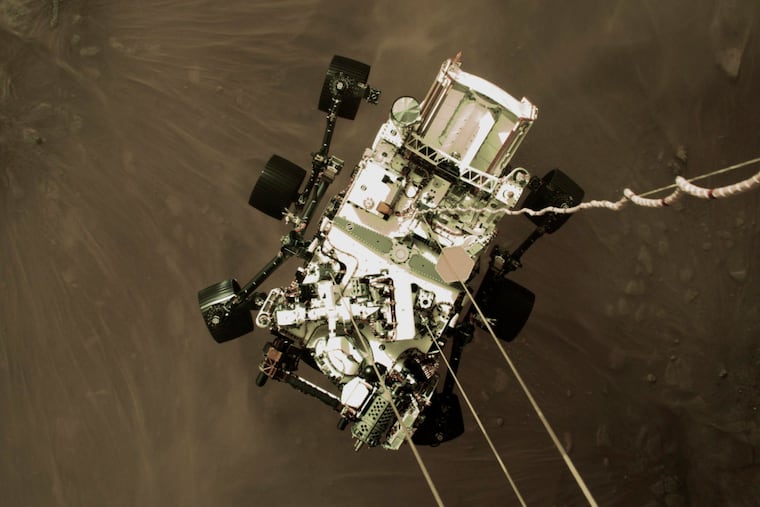In its quest to find life on Mars, the rover mission is having a remarkable week
The Mars rover will perform a variety of tasks, but its prime mission remains the big question: Are we alone?

How it will all end is impossible to predict, but the ultimate cosmic reality show has had quite a spectacular week.
After completing its seven-month flight and landing flawlessly in a three-billion-year-old Martian crater that scientists believe might once have been the site of a river delta, the NASA rover known as Perseverance has begun its investigation into that ultimate question: Are we alone?
“Everything is going about as we well as we could have expected,” DC Agle, with NASA’s Jet Propulsion Laboratory, in Pasadena, Calif., said Wednesday afternoon.
For a vehicle about the size of a Subaru Outback, executing the $3 billion mission to find out if primitive microbial life ever existed on Mars will be quite a remarkable exercise in ultra high-tech tedium.
“It’s just stunning that so much can be packed into the rover,” said Derrick Pitts, the Franklin Institute astronomer.
It is equipped with instruments that include subsurface radar and a weather station, a helicopter, and 23 cameras. On Monday, NASA released a video of touchdown that shows the heat shield peeling off the spacecraft. In just two minutes, it slows from more than 12,000 mph to 2 mph as it approaches the end of the descent.
It’s going to take years, but Perseverance — named by a seventh grader in an essay contest — eventually might answer the question of whether life as we know it could exist elsewhere.
For a mechanical device, controlled remotely, 38 million miles away, to go microbe-hunting on another planet is “pretty ambitious,” Pitts said.
What’s it doing out there?
As its predecessors did, the rover will be conducting reconnaissance of the planet’s geology, along with transmitting measurements of temperature, wind, pressure, humidity, and dust size.
It is quite a dusty place, given that it hasn’t rained there in a few billion years, and its storms are powerful enough to be detected by telescopes on Earth.
» READ MORE: Things are looking up, at least for skywatchers, with rare comet, and space-station sightings
The Mars helicopter, which was attached to the rover, will be attempting test flights once it acclimates to an environment where the temperature can drop to 180 degrees below zero Fahrenheit.
But Perseverance will be looking for bigger fish.
“All the other rovers have done the water-chasing,” said Pitts. The rover is using a pioneering drill technology to extract core samples of what NASA calls “the most promising rocks and soils” that will be set aside with the hope that a future mission will retrieve them for analysis.
Ultimately, NASA has a stated goal of sending humans to Mars.
One thing that Perseverance and its probing predecessors already have accomplished is demythologizing the Red Planet, frequently cast as a menacing force in movies and celebrated in Ray Bradbury’s Martian Chronicles short-story collection.
Could we live there some day?
Mars would have a few selling points.
It’s a great place to lose weight. It is about half Earth’s size, so you would end up losing two-thirds of your weight. A 300-pounder would become a lithe 100-pounder who also would acquire considerable leaping ability.
If you like spring and summers, they would last about twice as long on Mars since its annual trip around the sun takes 687 days. Temperatures approach 70 degrees near the Martian equator, according to the National Weather Service.
» READ MORE: Mars landing team 'awestruck' by photo of descending rover
Conversely, winters would be twice as long, and the overall planetary average temperature is about 81 below zero, compared with 58 above on Earth.
It is a bit far. The rover launch coincided with Mars’ closest approach to Earth, and it was still 38 million miles away. Besides, you might have to go BYOO (bring your own oxygen) since the atmosphere is 95% carbon dioxide.
Is this worth the cost?
“There’s no question $3 billion is a lot of money,” said Pitts. But the other question, he said, is: “What do we value? Do we value knowledge?
“I certainly do believe it’s worthwhile. The technology dribbles back to our world and benefits everyone.”